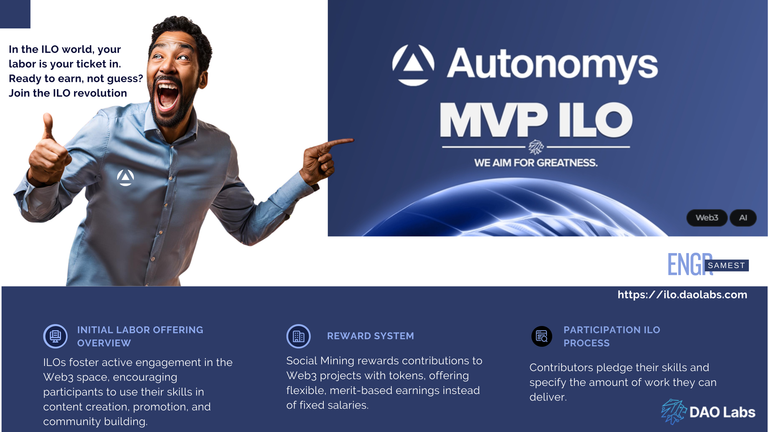In the early days of blockchain, token launches were all about speculation; early investors made predictions, placed their bets, and hoped the token value would spike. But this speculative model has left many community contributors and small investors behind while VCs and whales reaped the rewards.

Today, the Web3 ecosystem is shifting. A new model is emerging, one that values contribution over capital, participation over prediction.
Welcome to the era of the Initial Labor Offering (ILO).
What is an Initial Labor Offering (ILO)?
The Initial Labor Offering (ILO) is a decentralized, contribution-based token distribution model where individuals earn token allocations through meaningful participation and labor instead of upfront financial investment.
In an ILO, participants complete tasks such as creating content, engaging with communities, or spreading awareness to support an early-stage project. These contributions are evaluated and rewarded with token allocations at the time of the project’s Token Generation Event (TGE).
In short:
You don’t buy your way into the token launch. You work for it.
How ILO Works: A Step-by-Step Breakdown
1. Project Launches an ILO Campaign
- A new Web3 startup launches an ILO campaign, often in collaboration with platforms like Autonomys and DAO Labs.
- The campaign outlines tasks, KPIs, and a set timeframe (typically 1 month).
2. Participants Join the ILO Pledge Pools
- Anyone can join the ILO by pledging their time, skills, or influence.
- No capital investment is required, just commitment and contribution.
3. Social Mining Begins
- Participants actively contribute:
- Educating their audience about the project
- Creating content (threads, videos, infographics)
- Helping with community management or translations
- Onboarding new users
- These tasks are part of social mining, where contributions are transparent and measurable.
4. Evaluation and Contribution Scoring
- Contributions are tracked, scored, and verified through social mining tools and community feedback.
- Higher-quality, high-impact tasks receive greater weight.
5. Token Distribution at TGE
- Once the campaign ends and TGE takes place, tokens are distributed based on contribution scores.
- The more value you created, the more tokens you earn.
Why the ILO Model Matters
✅ For Contributors
- Fair Access: Anyone can participate, regardless of financial background.
- Skill-Based Rewards: Your talent, not your wallet, determines your outcome.
- Early Entry: Contributors are among the first to understand and support the project, gaining strategic advantage.
✅ For Projects
- Organic Awareness: Projects receive authentic word-of-mouth marketing.
- Community Foundation: Early contributors become invested evangelists.
- Token Loyalty: Since tokens are earned, not bought, participants are more likely to hold rather than dump.
The Autonomys x DAO Labs ILO: A Real-World Case Study
The Autonomys x DAO Labs ILO is a live application of this model, and it's turning heads for all the right reasons.
🔗 Who’s Involved?
- DAO Labs: A platform dedicated to social mining, empowering contributors to earn through participation in early-stage Web3 projects.
- Autonomys: A decentralized protocol focused on fair coordination, incentives, and value sharing within digital organizations.
⚙️ How It Works in Practice
- DAO Labs activates its social mining community through an ILO pledge campaign for Autonomys.
- Contributors learn about Autonomys’ mission, product, and vision during a 1-month campaign.
- They engage in meaningful activities, content creation, engagement, and outreach.
- Autonomys builds a loyal early user base while distributing tokens fairly and transparently.
This creates a win-win-win:
- DAO Labs gets real value from their community.
- Autonomys receives impactful growth and exposure.
- Contributors earn tangible rewards for meaningful labor.
Key Indicators of ILO Success
🔍 1. Community Quality Over Quantity
ILO participants aren't just airdrop hunters; they’re people who understand and believe in the project.
📈 2. Token Stability
Tokens distributed to engaged contributors are less likely to be dumped, ensuring healthier post-launch price action.
📢 3. Organic, Intensive Marketing
Contributors become advocates, not just users creating authentic buzz and educational content.
💼 4. Empowered Small Investors
Small contributors who might never afford a private sale now get fair access at the same stage as larger players.
ILO vs Traditional Token Launch Models
| Feature | Traditional ICO/IDO | Initial Labor Offering (ILO) |
|---|---|---|
| Participation | Based on capital | Based on contribution |
| Community | Often passive | Highly active and invested |
| Marketing | Paid & inorganic | Community-driven & authentic |
| Token Distribution | Often concentrated | Fair and merit-based |
| Risk | High (dumping, lack of commitment) | Lower (earned tokens, aligned incentives) |
The Future of Token Launches
ILO isn’t just an experiment; it’s a blueprint for how future projects can:
- Launch with strong community backing
- Align incentives from Day 1
- Reward contributors instead of speculators
This approach ensures that the people who build value get to capture it, something that’s long overdue in Web3.
Conclusion: Why You Should Care About ILOs
Whether you’re a builder, investor, or community member, the ILO model is a game-changer. It flips the power dynamic and puts value creation at the center of Web3 growth.
Through partnerships like Autonomys x DAO Labs, the ILO is becoming more than a concept, it’s a movement toward a fairer, more participatory digital economy.
🌟 In this new world, your labor is your investment.
🌟 Your voice becomes your value.
🌟 Your contribution unlocks your reward.
The revolution has started. It’s time to pledge your skills, not just your capital.